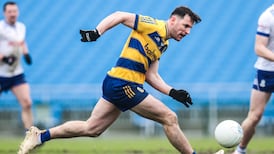On the morning of Sunday, April 14th, 1996, grand plans were hatched here in the Sports Department of the IT. They had to do with the opportunity of doing an elaborate spread on Greg Norman in anticipation of his winning the US Masters later that day, given that he led the field by six strokes.
I remember feeling particularly pleased with the fact that by 2.30 in the afternoon (7.30 p.m. Irish time), my contribution had been wrapped up. All that remained was the formality of the final round.
Four hours later, our special Shark extravaganza had been consigned to the waste bin. And a close relationship with coach Butch Harmon, who had guided his pupil to a magnificent triumph in the British Open at Royal St George's three years previously, came to a similarly abrupt end.
Four years on, the trauma of that extraordinary afternoon preyed on Harmon's mind as he stood on the practice ground at Pebble Beach last Sunday morning, watching Tiger Woods prepare for battle. As with Norman, just about everyone present was ready to hand the title to the leader who, on this occasion, had a 10-stroke advantage over the field.
"I have been in this position before and I really don't like it," said Harmon to American scribe Sal Johnson. Rather than Woods' triumph at Augusta in 1997, it was Norman's stunning reversal at the hands of Nick Faldo which was foremost on the coach's mind. Though he had been working with Woods at that time, Norman was his top client.
According to Johnson, Harmon will always carry the scars of Norman's disastrous day. And the result was that he took a decidedly negative view of Woods' preparations for what eventually proved to be a triumphant march to a record-breaking victory.
"He was a bit scared," said Harmon of his pupil's warm-up. "He really didn't know what to expect."
Indeed Harmon went so far as to suggest that his star pupil wasn't swinging as well as on previous days. But he added: "Tiger may have been scared before the round, but once he got out on the course, it was back to normal."
That was when Woods, among other things, paid off an investment his father, Earl, had made in his career 11 years previously - 6,400 times over, to be precise. In 1989, when his 13-year-old son stood only 5 ft 6 in and weighed 7 st 9 lb, Earl considered it a crucial part of his golfing development that he should play Pebble Beach.
So, for a green-fee of $125, the lad set off on a wet and windy morning, the day after Mark O'Meara had captured the Pebble Pro-Am by a stroke from Tom Kite. In the event, Tiger hit a six-iron to the seventh, where a sandwedge sufficed 11 years later, and a three-wood second shot to the ninth and 10th, where he used a pitching wedge last Sunday.
And the ultimate irony regarding events of last weekend is that Faldo, Norman's conqueror at Augusta, claimed to have achieved one of his goals for the US Open by, as he put it, "finishing less that 20 strokes back from Tiger".
"It's too early to say where he falls as far as the greats of the game are concerned, but I don't think it's too early to say this: you watch him play and you say, `I feel privileged to have lived in his time'."
- USGA executive director David Fay on Tiger Woods.
During a trip to Tokyo about 15 years ago, I remember marvelling at the general buoyancy of the golf industry there, which included 4,000 driving ranges. Now, the game is facing a major crisis, with as many as 1,700 of the country's courses either bankrupt or facing financial ruin.
As a leading Japanese financial expert pointed out in a recent report: "It is very difficult to exactly calculate the extent of the bad-loan problem in this country. Some people estimate it at $1.2 trillion. Maybe 20 per cent of that is related to the golf course crisis."
With the construction of as many as 2,400 courses during the 1980s, families borrowed heavily to buy club memberships. Now, entire life savings are being wiped out. In desperation, some club members turned to organised crime to help recover their losses. In turn, the yakuza have been retained by certain clubs to "discourage" disgruntled members from suing.
Mitsuko Fujii, a 64-year-old deputy director of a golf school, is among those who have suffered. "I think the banks were the most guilty party but I also feel responsible," she said. "I listened to the promoters who told me if I buy something in Japan that is tied to the price of land, its value will never go down. My judgment failed."
Tiger Woods pushed his tee-shot on the 16th behind a towering fir tree. Looking towards his playing partner, Arnold Palmer, Woods asked: "How would you play this one? Lay up and hope to pitch and putt for par?"
"Never," came the reply. "When I was your age and in the same situation, I played right over that tree."
Whereupon Woods opened the face of his lob-wedge as wide as he dared, took a full swing and proceeded to clatter the ball off the tee and out of bounds. Furious with himself, he questioned how Palmer could ever have cleared the tree.
"Well," replied Arnie with a sly grin, "when I was your age, that tree was no more than six feet tall."
Given the various obstacles which had to be overcome, Dick Spring permits himself a quiet glow of satisfaction at the staging of the Murphy's Irish Open at Ballybunion next week. And while talking from the left, presumably, he gave the assurance: "We shall do it right."
The former Tanaiste and leader of the Labour Party planted the seed of a possible Ballybunion staging in the minds of tournament director David Linnane and Padraig Liston of Murphy's during a chat at Druids Glen a few years ago.
"To be perfectly frank about it, I wanted to bring the event to my constituency," he said.
When the idea took hold, Spring played an active role in seeing it through its various problems, even to the point in assisting with Government funding. But in a strictly sporting context, he said: "It is a benchmarking in relation to how the professionals will handle our course."
Over the years, Pebble Beach has been a popular setting for dramatic happenings - and they didn't always involve the Royal and Ancient game. In fact the course and its environs has figured in numerous movies, going back to the silent days when Eric Von Stroheim directed and starred in Foolish Wives which, in 1921, was hailed as Hollywood's first million-dollar production.
Then there was Rebecca in 1939 when, with the cameras still rolling after a passionate on-camera kiss, Laurence Olivier is reputed to have murmured to co-star Joan Fontaine: "Was that the best you could do?" And The Sandpiper starring Elizabeth Taylor and Richard Burton was also shot there.
It seems that having gone there to work, the stars stayed on to play golf and relax. This was a tradition dating back to the early years of the course when the owner, Samuel Morse, was a friend of Mary Pickford and Douglas Fairbanks, the acknowledged Hollywood royals of the time.
Meanwhile, from a golfing standpoint, the movie which stands apart from all others at Pebble Beach is Follow the Sun, the life story of Ben Hogan in which Glenn Ford played the great man while Anne Baxter took the role of Hogan's wife, Valerie.
This day in golf history . . . On June 24th, 1956, Ben Hogan and Sam Snead teamed up to win the Canada Cup for the US at Wentworth, where they finished a record, 14 strokes clear of second-placed South Africa, represented by Bobby Locke and Gary Player.
Teaser: Through the green, a player's ball was embedded in its pitchmark in a closely mown area. The player lifted the ball under Rule 25-2 but, before dropping it, repaired the pitch-mark. Is such repair permissible?
Answer: No. The player was in breach of Rule 13-2 when he improved the area in which his ball was to be dropped by pressing down an irregularity of surface.









